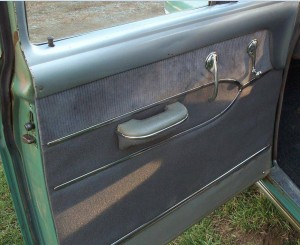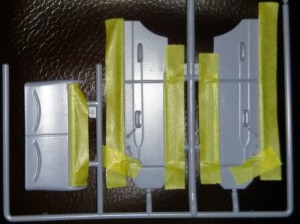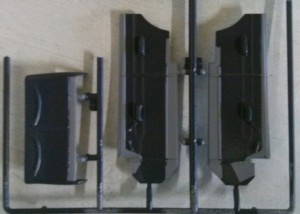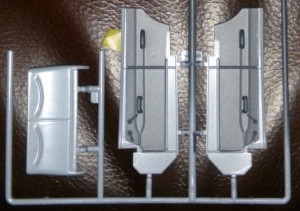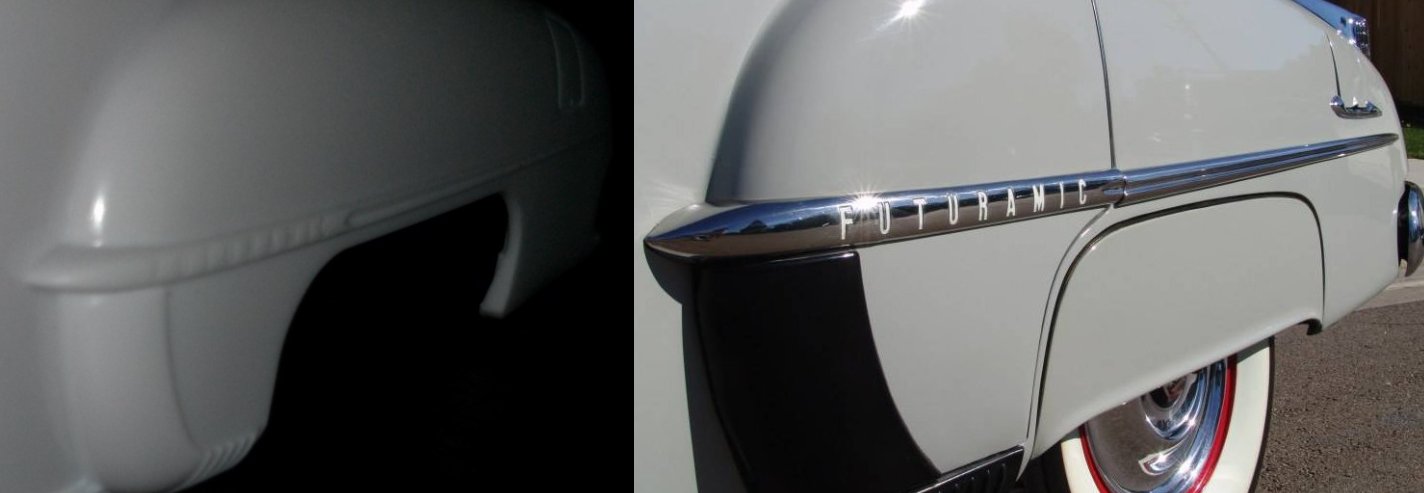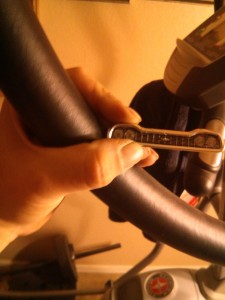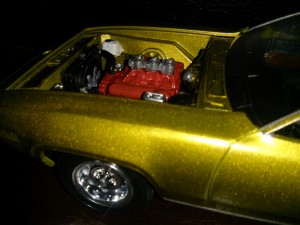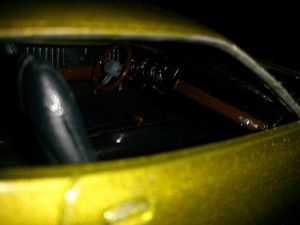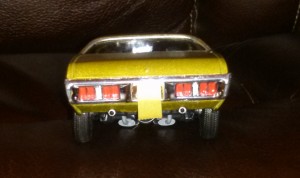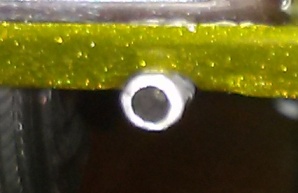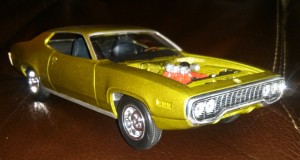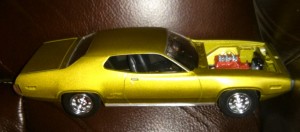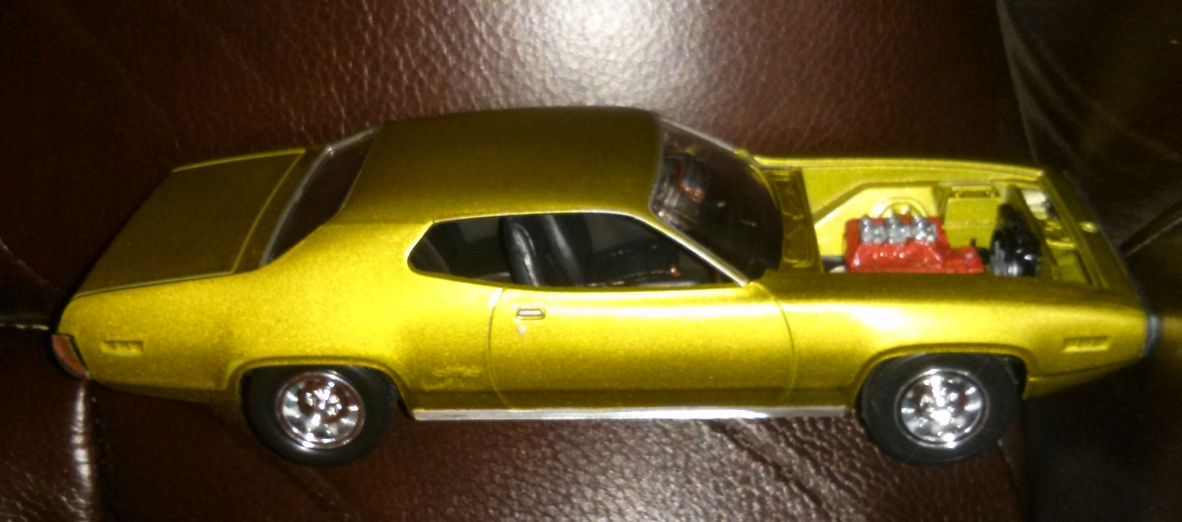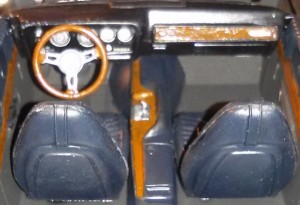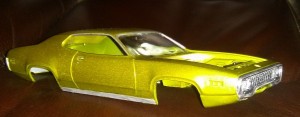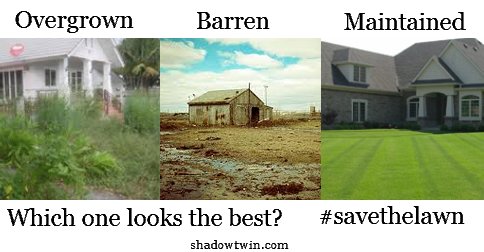When I was young, I always liked building models. At least I enjoyed the idea of building models. In practice, I was far too impatient to do it with any sort of success. I would greet each new kit I would get (my aunt, Janice, would get each of us a kit every year for Christmas) with an enthusiasm that is hard to match in my adult life. It was the enthusiasm of a child, but always mixed with the ultimatum that this time, I’m going to do it right. Fast forward an hour and I have realized that the paint on the body has brush strokes all through it, I’ve managed to get a big fingerprint right in the center of the hood, and somehow there seems to be cat hair under the paint on the trunk (we didn’t have a cat). My disappointment would be almost as great as the initial enthusiasm. Being ten or twelve years old, I didn’t have the patience, dexterity or supplies to finish a model like it looked on the box. I could usually get the engine to look okay, but the rest of it would look horrible.
I lacked not only patience, but also proper supplies. The buy-in to build a model kit can be as little as the cost of the kit and ten bucks worth of glue and paint, but you can’t get decent results with those meager supplies. Buying the proper supplies -primer, liquid enamel paint, spray paint, clear coat, knives, sprue cutters, glue, clear glue, sandpaper, sanding cloths, sanding sticks, buffing cloths, needle files, polishing compound, and on and on- can get horribly expensive.
 In my adult life, I frequently see other people building models and think with the proper supplies, I could do that. With inspiration from my brother-in-law, I’ve decided to put that to the test. To the right is the model kit I’ve decided to start with. I wanted to build a ’72 Roadrunner like the one I rode around in with Dave back in high school, but the kit for it doesn’t exist. The nearest I could get was a ’71 GTX. I’m going to make a couple of slight modifications to the kit (which I won’t list just yet as I’ll have to see if my ability to do so matches my eagerness to try) and have found paint that should get pretty close to the one from my teenage days. I’ve spent far more than I care to admit to acquire some decent, entry-level supplies (entry level for a serious adult modeler – which is still quite expensive) and have done considerable research into painting and finishing techniques. We’ll see how it goes. Here I should also note that I have so much confidence in my ability that I actually bought two of these kits with plans to experiment with different paint colors and techniques on one of them (which will ultimately become either spare parts or trash).
In my adult life, I frequently see other people building models and think with the proper supplies, I could do that. With inspiration from my brother-in-law, I’ve decided to put that to the test. To the right is the model kit I’ve decided to start with. I wanted to build a ’72 Roadrunner like the one I rode around in with Dave back in high school, but the kit for it doesn’t exist. The nearest I could get was a ’71 GTX. I’m going to make a couple of slight modifications to the kit (which I won’t list just yet as I’ll have to see if my ability to do so matches my eagerness to try) and have found paint that should get pretty close to the one from my teenage days. I’ve spent far more than I care to admit to acquire some decent, entry-level supplies (entry level for a serious adult modeler – which is still quite expensive) and have done considerable research into painting and finishing techniques. We’ll see how it goes. Here I should also note that I have so much confidence in my ability that I actually bought two of these kits with plans to experiment with different paint colors and techniques on one of them (which will ultimately become either spare parts or trash).
The first issue with these model kits -the part that, to me has always screamed amateur- is the pre-chromed pieces that come in the kits. In the kit I am building, the bumpers and a few other pieces come already chromed. The issue with that is that the grill -all of it- is in chrome. Not just the parts that should be chrome -the trim parts running around the edge of it- but the whole thing, even the parts that should be a dark color because they are, theoretically, the parts where you can see through to the radiator. In the picture from the box (inset above) you can see that they have painted those parts dark to make the grill look more realistic. I’m not sure how they managed that since the portions that need to be painted dark are only a couple of millimeters wide. I know I don’t have the ability to use a brush with that level of precision.
Before I decided to buy a model and give it a go, one of the things I researched was how to strip the chrome from these pre-finished pieces. I found a video on youtube that said it stripping the chrome was as simple as soaking the parts in bleach for a few minutes. I was a bit skeptical, since that seems so darn easy. The first thing I did when I got the kit was to clip a piece of scrap from the chromed pieces and try this (the videos I found are all British and the bleach they use is thicker than what is available to me, so I wanted to check it on garbage first). It turns out that it was just as easy as the video shows. I got the cheapest bleach available at the local dollar store for my purposes. It took about two minutes for large, flat pieces and about ten minutes for pieces with the smaller detail (like the grill of the car I am working on). I actually soaked it for a few minutes, rinsed it, soaked it a few more minutes, rinsed it. I agitated it while doing so to get some of the pesky bits that were stuck in the corners, but in about ten or twelve minutes, it was stripped down to white plastic.
 The grill of this model was one of two things I thought I might have issue with, and thus the part I wanted to work on first. I didn’t snap a picture of the grill with the chrome or during the chrome stripping (there’s a link above to a youtube video of the process), but once I got it stripped and primed, I was pretty happy with the results. Getting the chrome off of it made the details really pop when the primer coat hit it. My particular kit had a lot of stray edges and plastic around the headlight openings and throughout the detail work which took me a good half an hour to clean up with an x-acto knife and a q-tip, but it cleaned up pretty well.
The grill of this model was one of two things I thought I might have issue with, and thus the part I wanted to work on first. I didn’t snap a picture of the grill with the chrome or during the chrome stripping (there’s a link above to a youtube video of the process), but once I got it stripped and primed, I was pretty happy with the results. Getting the chrome off of it made the details really pop when the primer coat hit it. My particular kit had a lot of stray edges and plastic around the headlight openings and throughout the detail work which took me a good half an hour to clean up with an x-acto knife and a q-tip, but it cleaned up pretty well.
 Here is what it looks like with some flat black and bare metal foil applied. It’s not perfect, but it’s my first model detail painting in a couple of decades. Now if I can get the body paint down, I’ll have passed the second major hurdle I was expecting. (As an aside, I can’t continue working on it because I’m still waiting on the paints I ordered from Hobbytown.com. Do not buy supplies from them. They were one of a handful of sites that had the color of body paint I wanted and they offer flat five dollar shipping, which is what suckered me in, but four days after completing paypal checkout for my order, they still haven’t even processed the order, let alone shipped it. I reordered many of the paints from TowerHobbies.com, in slightly different shades so I wouldn’t have duplicates, and they had them in the mail the same day. I should have them tomorrow – meanwhile, Hobbytown still hasn’t processed my order. Very frustrating).
Here is what it looks like with some flat black and bare metal foil applied. It’s not perfect, but it’s my first model detail painting in a couple of decades. Now if I can get the body paint down, I’ll have passed the second major hurdle I was expecting. (As an aside, I can’t continue working on it because I’m still waiting on the paints I ordered from Hobbytown.com. Do not buy supplies from them. They were one of a handful of sites that had the color of body paint I wanted and they offer flat five dollar shipping, which is what suckered me in, but four days after completing paypal checkout for my order, they still haven’t even processed the order, let alone shipped it. I reordered many of the paints from TowerHobbies.com, in slightly different shades so I wouldn’t have duplicates, and they had them in the mail the same day. I should have them tomorrow – meanwhile, Hobbytown still hasn’t processed my order. Very frustrating).
The second thing with this car that I thought I would have issues with is what has plagued me since I first put brush to plastic on my first model: the body paint. Youtube has a ton of tutorials on how NOT to make it look like your car was painted by a developmentally challenged six-year-old, and I watched most of them. I found this 5 part series to be quite informative. A lot of the tips are really no-brainer type stuff, but the tutorial is broken into smaller videos which makes navigating to the part you are interested in easier. Part three has a lot of information on polishing the paint once applied, and while I won’t be using the same products they did (which are horribly expensive) the same techniques will apply to any finishing compound.
 My biggest takeaway from all the videos I watched was the whole part of applying many thin coats instead of one thick coat. I can clearly remember trying to get all the paint on in one application when I was doing these as a kid which led to pooling and dripping. When I applied the primer to this one, I did it in three very thin coats. The photo here is after finishing the third coat. I still need to hit it with some wet/dry paper to smooth out the texture (I’m going to wait a day or two since I still don’t have the body paint anyway), but aside from that it looks pretty darn good. I used an 1800 grit sanding cloth between applications to remove blemishes and take excess paint off of the emblems, trim and door hardware (which probably wasn’t strictly necessary) and it left the final coat looking pretty darn good. I could leave it as is and it would look better than the finished paint job on the last model I built (some thirty years ago).
My biggest takeaway from all the videos I watched was the whole part of applying many thin coats instead of one thick coat. I can clearly remember trying to get all the paint on in one application when I was doing these as a kid which led to pooling and dripping. When I applied the primer to this one, I did it in three very thin coats. The photo here is after finishing the third coat. I still need to hit it with some wet/dry paper to smooth out the texture (I’m going to wait a day or two since I still don’t have the body paint anyway), but aside from that it looks pretty darn good. I used an 1800 grit sanding cloth between applications to remove blemishes and take excess paint off of the emblems, trim and door hardware (which probably wasn’t strictly necessary) and it left the final coat looking pretty darn good. I could leave it as is and it would look better than the finished paint job on the last model I built (some thirty years ago).
 I finally received the paint I ordered from Hobbytown -a full ten days after ordering it- so I could get to work on the body. The color I chose is called ‘Lime Gold Metal Flake’. Note the words metal flake at the end. In my naivete, I assumed that metal flake paint would go on just the same as normal paint and just look kind of, well, flaky. Nope. Not at all. My first two mist coats were impossibly lightly sprayed -to the point that the car was still mostly primer after completing them- but there were still pools and drips galore in the paint. It took a ridiculous amount of sanding and smoothing to get it to look even remotely uniform in color (this could also have something to do with the age of the paint. This color has been discontinued but I don’t know for how long. It could have been sitting on the shelf for years). The picture I posted here doesn’t do the finish justice; it is very smooth and looks wonderful… Except some discoloration on the driver’s door that I just couldn’t sand/polish away. It’s like I told my brother-in-law, It’s going to be like your breakfast pancakes: the first one never looks very good.
I finally received the paint I ordered from Hobbytown -a full ten days after ordering it- so I could get to work on the body. The color I chose is called ‘Lime Gold Metal Flake’. Note the words metal flake at the end. In my naivete, I assumed that metal flake paint would go on just the same as normal paint and just look kind of, well, flaky. Nope. Not at all. My first two mist coats were impossibly lightly sprayed -to the point that the car was still mostly primer after completing them- but there were still pools and drips galore in the paint. It took a ridiculous amount of sanding and smoothing to get it to look even remotely uniform in color (this could also have something to do with the age of the paint. This color has been discontinued but I don’t know for how long. It could have been sitting on the shelf for years). The picture I posted here doesn’t do the finish justice; it is very smooth and looks wonderful… Except some discoloration on the driver’s door that I just couldn’t sand/polish away. It’s like I told my brother-in-law, It’s going to be like your breakfast pancakes: the first one never looks very good.
There were a couple of other issues on the body paint front: 1) I was nearly out of paint by the time I started doing the scoop on the hood (which is in black on the model image, but which I wanted to make body color and it doesn’t quite match). 2) I failed to install the side mirrors at any point during the painting process. I have them painted, but not installed. If I attempt to install them now, it will totally fuck the body paint and I used the entire can trying to get the rest of it smooth. It looks like this one might not have side mirrors.
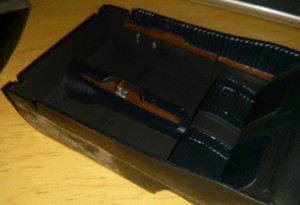 Having now established that I not capable of finishing the body paint in anything approaching a professional manner, I jumped right into the interior detailing. My first attempt was with a brush and came out horribly. So interior pan number one got thrown aside. Interior pan number two, I took a different approach and bought some off-the-rack Krylon Fusion paint in a satin black finish (I bought several cans in other colors as well). This stuff goes for four bucks a can, is about three times the size of Testors, Model Master or Tamiya paint and dries enough to work with in fifteen minutes instead of hours. I wouldn’t try to do a body finish with it, but for interior and undercarriage type stuff it does the job just fine. I sprayed the whole pan in satin black then went back in and added wood grain and silver where necessary. I also hand brushed the seats, tufted parts of the doors, and the center console in a semi gloss gun metal color which is why they appear to be a slightly different color. This part came out okay, but I got a little sloppy with the wood grain color. It was a lesson learned.
Having now established that I not capable of finishing the body paint in anything approaching a professional manner, I jumped right into the interior detailing. My first attempt was with a brush and came out horribly. So interior pan number one got thrown aside. Interior pan number two, I took a different approach and bought some off-the-rack Krylon Fusion paint in a satin black finish (I bought several cans in other colors as well). This stuff goes for four bucks a can, is about three times the size of Testors, Model Master or Tamiya paint and dries enough to work with in fifteen minutes instead of hours. I wouldn’t try to do a body finish with it, but for interior and undercarriage type stuff it does the job just fine. I sprayed the whole pan in satin black then went back in and added wood grain and silver where necessary. I also hand brushed the seats, tufted parts of the doors, and the center console in a semi gloss gun metal color which is why they appear to be a slightly different color. This part came out okay, but I got a little sloppy with the wood grain color. It was a lesson learned.
The motor presented me with another dilemma. This one was just about color. Mopar has used way too many colors for their engines over the years, some of which were used only briefly (some only for a single model engine). The 440 six pack on this one should be done in a pale orange. However, I remember the engine from Dave’s Roadrunner being red. This could be the product of a faulty memory or aftermarket paint, but I do know that Dave’s didn’t have the famed 440 six pack (I believe the motor was dropped in 72 to meed stricter emission guidelines). Red was a color used on other Mopar engines at the time though, so that is what I went with. Also, I’d be lying if I said that not wanting to buy a bottle of orange paint for this motor and knowing I would never be able to use it again wasn’t a factor. Below, you’ll see the standard 440 six pack color on the left (and, incidentally, I believe that is the body color I was trying to match) while the image on the right is the non 440 six pack color I was shooting for.
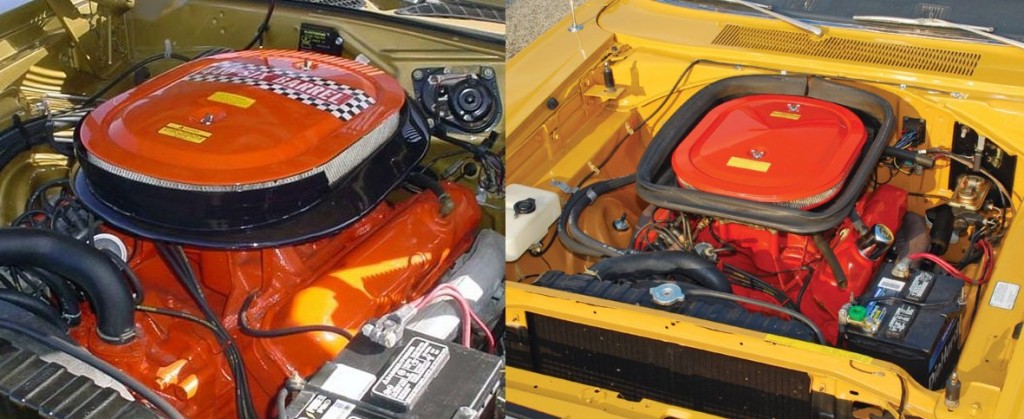
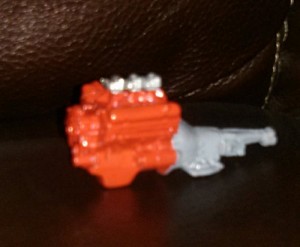 For the engine, I went with another Krylon paint, this one in a satin red. I painted all the engine parts this color (including the chrome) before going back over it with a brush and Chrysler Engine Red paint. The red engine paint is a close enough match for many muscle car motors so I’ll get some more use out of it later on. The only piece of the engine that I didn’t do in standard engine color is the carburetor. This came finished in chrome, which I painted over with some metallic gloss silver to look a bit more like an actual engine component. It pained me to paint over the shiny chrome valve covers and air filter (which were usually the first two pieces of any V8 motor that I would rush out and get in chrome when I was driving such cars). Keeping the first pancake theory in mind, I’m not going to do a lot of detail on the engine. I did the belts and pulleys, hoses and etc. but I’m not going to go so far as to do the starter and other components since this model will likely be hidden away once I finish my second pancake.
For the engine, I went with another Krylon paint, this one in a satin red. I painted all the engine parts this color (including the chrome) before going back over it with a brush and Chrysler Engine Red paint. The red engine paint is a close enough match for many muscle car motors so I’ll get some more use out of it later on. The only piece of the engine that I didn’t do in standard engine color is the carburetor. This came finished in chrome, which I painted over with some metallic gloss silver to look a bit more like an actual engine component. It pained me to paint over the shiny chrome valve covers and air filter (which were usually the first two pieces of any V8 motor that I would rush out and get in chrome when I was driving such cars). Keeping the first pancake theory in mind, I’m not going to do a lot of detail on the engine. I did the belts and pulleys, hoses and etc. but I’m not going to go so far as to do the starter and other components since this model will likely be hidden away once I finish my second pancake.
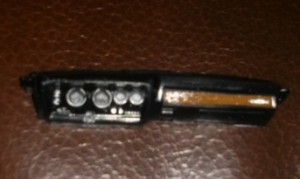 Next up was the dashboard. Having learned a lesson from my freehand painting of the wood grain in the previous image, I took the time to lay down some 10mm Tamiya Masking Tape
Next up was the dashboard. Having learned a lesson from my freehand painting of the wood grain in the previous image, I took the time to lay down some 10mm Tamiya Masking Tape for this. The edges of the wood grain are much sharper in this one and without a lot of bleed. The masking tape was worth the few bucks and it is much easier to maneuver around uneven surfaces and corners than a larger tape. I also purchased some FrogTape
for this. The edges of the wood grain are much sharper in this one and without a lot of bleed. The masking tape was worth the few bucks and it is much easier to maneuver around uneven surfaces and corners than a larger tape. I also purchased some FrogTape for use on larger areas. The dash is supposed to have wood grain around the instrument cluster and stereo knobs as well, but I didn’t think I would have been able to pull that off even with masking tape. Instead, I did it all with Krylon satin black and followed up with some flake silver paint to circle the instrument clusters and coat the knobs as well as the GTX logo in the wood grain. The dash looks so much better than the interior pan. Already on my way to my second pancake!
for use on larger areas. The dash is supposed to have wood grain around the instrument cluster and stereo knobs as well, but I didn’t think I would have been able to pull that off even with masking tape. Instead, I did it all with Krylon satin black and followed up with some flake silver paint to circle the instrument clusters and coat the knobs as well as the GTX logo in the wood grain. The dash looks so much better than the interior pan. Already on my way to my second pancake!
 I still have a ways to go on this, but I do have most of the painting done (I’ve found, as many modellers lacking supplies have, that it is easier to paint the small parts on the tree and touch up after the fact than to cut them out and paint them later. If I build another model I will probably invest in some alligator clips on a stick
I still have a ways to go on this, but I do have most of the painting done (I’ve found, as many modellers lacking supplies have, that it is easier to paint the small parts on the tree and touch up after the fact than to cut them out and paint them later. If I build another model I will probably invest in some alligator clips on a stick so I can cut the sprues and trim the rough edges to eliminate painting everything twice). I went my own way with most of the colors here. The whole thing is painted with Krylon satin black and most of the rest of the components are painted up and ready to got. I thought the steering wheel would look better in silver and wood grain than black with a wood center that was recommended. The silver for the exhaust manifolds and gray for the pipes feels right (and hopefully will look right, too). I did the leaf springs, axle and differential in the gun metal semi gloss so it would be a different color than the flat black frame (I don’t think it looks right when you flip a model over and everything except the exhaust is the same color). I also have a drive line from the other kit that I did with both black and gray to try to make it look not so brand new. I’ll see which one I like better.
so I can cut the sprues and trim the rough edges to eliminate painting everything twice). I went my own way with most of the colors here. The whole thing is painted with Krylon satin black and most of the rest of the components are painted up and ready to got. I thought the steering wheel would look better in silver and wood grain than black with a wood center that was recommended. The silver for the exhaust manifolds and gray for the pipes feels right (and hopefully will look right, too). I did the leaf springs, axle and differential in the gun metal semi gloss so it would be a different color than the flat black frame (I don’t think it looks right when you flip a model over and everything except the exhaust is the same color). I also have a drive line from the other kit that I did with both black and gray to try to make it look not so brand new. I’ll see which one I like better.
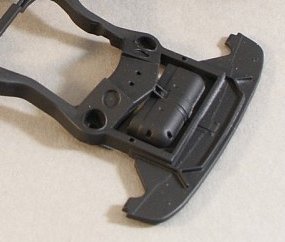 In my brief time working on these models, one lesson I haven’t quite yet learned is to take pictures before instead of just after. In the case of the frame, I have a before, but it’s not from the car I’m building. Nonetheless, it will serve to illustrate my point, so here it is. One of the great things about this Revell ’50 Olds Coupe Kit
In my brief time working on these models, one lesson I haven’t quite yet learned is to take pictures before instead of just after. In the case of the frame, I have a before, but it’s not from the car I’m building. Nonetheless, it will serve to illustrate my point, so here it is. One of the great things about this Revell ’50 Olds Coupe Kit is that the floor panel is a separate piece from the frame. This made it really easy to paint the frame in black and the pan in grey. However, when test fitting the pieces, it looked odd having the front portion of this in black. You can see where the frame comes out and makes a nice little rectangle there but the rest of the front of the car is attached to the frame because the engine compartment makes it impossible to attach it to the portion with the floor. I don’t like that.
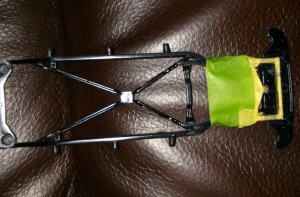 Enter tape! And I mean a lot of tape. I took my little Tamiya 10MM Masking Tape
Enter tape! And I mean a lot of tape. I took my little Tamiya 10MM Masking Tape roll and just went to town. Because of the very small size of the frame, even the 10mm tape was way too wide. I had to cut it into tiny little pieces and apply them in bits. No piece of that tape is longer than probably a half an inch, and each was subsequently trimmed with a razor and tucked in place with a toothpick. Once all the small parts were taped, I followed that up with some FrogTape
to cover the larger areas (the part beyond that was covered with an old envelope while I painted it).
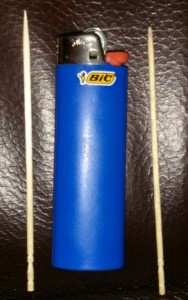 When I say I use a ‘toothpick’, I should specify that it’s not really a toothpick. It’s the behemoth you see in the picture here (shown next to a bic lighter for scale). These are Diamond Extra Long Toothpicks (linked to Target because they aren’t available on Amazon). My wife had these in the cabinet when I started on the first model and I’ve found them to be indispensable ever since. They are far more rigid than a normal toothpick, but soft enough that they don’t do any damage to the plastic. You do have to be careful around paint, but that’s true of most tools. The one on the left of the lighter is what they look like out of the box, while the one on the right is what a battle-worn one looks like. Once the tip gets rounded over a bit, they get considerably better for maneuvering small pieces without getting stuck on edges and the such. Fresh from the box, they are great for tucking the tape into tight corners you wouldn’t otherwise be able to reach. Because they are thicker than standard toothpicks, you can put enough pressure on them to get some really sharp corners.
When I say I use a ‘toothpick’, I should specify that it’s not really a toothpick. It’s the behemoth you see in the picture here (shown next to a bic lighter for scale). These are Diamond Extra Long Toothpicks (linked to Target because they aren’t available on Amazon). My wife had these in the cabinet when I started on the first model and I’ve found them to be indispensable ever since. They are far more rigid than a normal toothpick, but soft enough that they don’t do any damage to the plastic. You do have to be careful around paint, but that’s true of most tools. The one on the left of the lighter is what they look like out of the box, while the one on the right is what a battle-worn one looks like. Once the tip gets rounded over a bit, they get considerably better for maneuvering small pieces without getting stuck on edges and the such. Fresh from the box, they are great for tucking the tape into tight corners you wouldn’t otherwise be able to reach. Because they are thicker than standard toothpicks, you can put enough pressure on them to get some really sharp corners.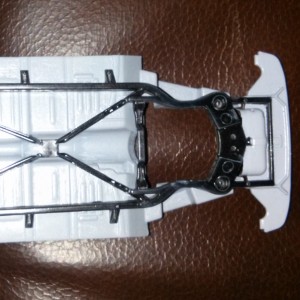 I really had to turn off my OCD for this one. I knew it wasn’t going to be anything close to perfect due to the tiny size of the frame being taped and my not-so-steady hand. It certainly looks passable (although a bit better in the picture than in person. While the frame itself looks better in person than in the photo so Megapixels giveth and Megapixels taketh away). I snapped this one with the frame sitting in place on the body to illustrate what I meant about it looking wrong for the whole thing to be black. With the front portion now matching the grey of the rest of the underside, it looks much better in my opinion. Was it worth the thirty minutes of mumbled obscenities as I tried to lay down pieces of tape about 1/8 the size of a postage stamp that didn’t want to cooperate? Probably not. Sometimes you just do things to see if you can.
I really had to turn off my OCD for this one. I knew it wasn’t going to be anything close to perfect due to the tiny size of the frame being taped and my not-so-steady hand. It certainly looks passable (although a bit better in the picture than in person. While the frame itself looks better in person than in the photo so Megapixels giveth and Megapixels taketh away). I snapped this one with the frame sitting in place on the body to illustrate what I meant about it looking wrong for the whole thing to be black. With the front portion now matching the grey of the rest of the underside, it looks much better in my opinion. Was it worth the thirty minutes of mumbled obscenities as I tried to lay down pieces of tape about 1/8 the size of a postage stamp that didn’t want to cooperate? Probably not. Sometimes you just do things to see if you can.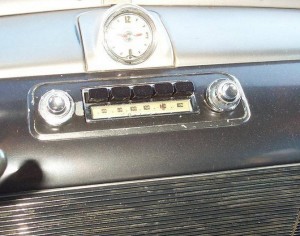 Also today, I got the second (of three) paint colors on the dash. For those of you keeping track at home, I happened across one of these cars for sale and have more than adequate pictures of what the interior should look like. The dash should be a light color on the top with a dark color in the center. The grill looking area will need to be done in a silver or chrome. Ideally looking much like the picture here. Or at least as close as I can reasonably come to it. The kit came with decals for the clock and speedometer which means I’ll only have to worry about tiny little details with the stereo and other knobs. Hopefully I can pull that off (the knobs are another thing I am hoping to be able to do with the Sharpie Oil-Based Paint Markers, Extra Fine Point, Metallic
Also today, I got the second (of three) paint colors on the dash. For those of you keeping track at home, I happened across one of these cars for sale and have more than adequate pictures of what the interior should look like. The dash should be a light color on the top with a dark color in the center. The grill looking area will need to be done in a silver or chrome. Ideally looking much like the picture here. Or at least as close as I can reasonably come to it. The kit came with decals for the clock and speedometer which means I’ll only have to worry about tiny little details with the stereo and other knobs. Hopefully I can pull that off (the knobs are another thing I am hoping to be able to do with the Sharpie Oil-Based Paint Markers, Extra Fine Point, Metallic . Of course I haven’t yet gotten them so this could all be moot).
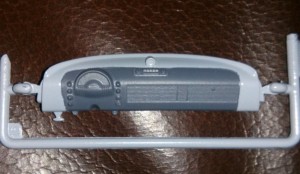 This is the first piece I ruined so badly on the first shot that I actually stripped the paint back down to plastic and started over. Logic says that when you are painting something like this, you’d want to paint the light color first, then tape off the light portion to go back over it in the darker color. This didn’t work at all. The second coat of paint stripped so much detail from the knobs and grill that you could hardly tell what they were supposed to be. With some paint thinner, a brush, some elbow grease and a half an hour, I got it back down to bare, white plastic and started over. The second time, I painted the whole piece in the darker color first, then taped it off to paint the lighter color. Counter-intuitive for sure, but the result was much less paint on the more detailed areas. As you’ll no doubt see in the photo, taping around those tiny elements wasn’t exactly easy. I have a couple of spots that aren’t as straight as I would like them, but it’s like my Dad always said, “if at first you don’t succeed, lower your expectations.”
This is the first piece I ruined so badly on the first shot that I actually stripped the paint back down to plastic and started over. Logic says that when you are painting something like this, you’d want to paint the light color first, then tape off the light portion to go back over it in the darker color. This didn’t work at all. The second coat of paint stripped so much detail from the knobs and grill that you could hardly tell what they were supposed to be. With some paint thinner, a brush, some elbow grease and a half an hour, I got it back down to bare, white plastic and started over. The second time, I painted the whole piece in the darker color first, then taped it off to paint the lighter color. Counter-intuitive for sure, but the result was much less paint on the more detailed areas. As you’ll no doubt see in the photo, taping around those tiny elements wasn’t exactly easy. I have a couple of spots that aren’t as straight as I would like them, but it’s like my Dad always said, “if at first you don’t succeed, lower your expectations.” 
